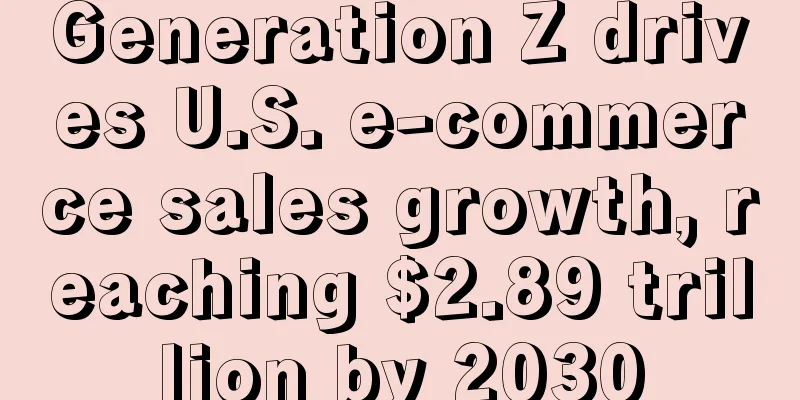Generation Z drives U.S. e-commerce sales growth, reaching $2.89 trillion by 2030

|
It is learned that according to foreign media reports, data from Bloomberg Intelligence shows that by 2030, Generation Z is expected to account for about 17% of US sales, driving e-commerce sales to increase 1.75 times to US$2.89 trillion. The report shows that more than 30% of Gen Z consumers classify themselves as "beauty enthusiasts", which is almost twice the proportion of consumers as a whole. Although the number of Gen Z consumers with regular skin care habits (33.5%) is almost the same as the overall level (36%), more than 75% of Gen Z consumers regularly use products beyond basic beauty essentials. Meanwhile, the shopping behavior of Generation Z is deeply influenced by social media. Nearly 80% of Generation Z believe that social media is the best way to find new beauty products, which is much higher than that of Millennials (62%) and Generation X (42%). The influence of social media has made Generation Z more eager to try new products. More than 40% of Generation Z list "trying new products" as the primary motivation for shopping, which is higher than that of Millennials (37%) and Generation X (29.5%). 45% of Generation Z consumers spend $50 or more at beauty retailers each time, further indicating their strong interest in this field. Generation Z’s preference for secondhand clothing is also leading the growth of e-commerce in the United States. Forecasts show that Generation Z may drive U.S. e-commerce sales (including clothing) to grow 1.75 times to $2.89 trillion by 2030, with a compound annual growth rate of 8%. In the past year, 65% of Generation Z and millennial consumers bought secondhand clothing, compared with 52% of overall U.S. consumers. In addition, resale platforms have become the main channel for Generation Z to shop, with 63% of second-hand clothing consumers choosing to buy online, while this proportion is as high as 71% among Generation Z and Millennials. When buying clothing, 41% of overall consumers and 50% of Generation Z and Millennials will first look for second-hand goods. At the same time, 25% of overall consumers and 33% of Generation Z and Millennials will choose to resell old clothes. According to eMarketer, Gen Z is more likely to use platforms like Depop, OfferUp and Poshmark, while millennials are more likely to use Bonanza, The RealReal and ThredUp. Author ✎ Rayna/ Statement: This article is copyrighted and may not be reproduced without permission. If you need authorization, please contact: happy |
<<: U.S. holiday online sales to reach $240.8 billion in 2024, up 8.4%
>>: Costco Q4 financial report released: e-commerce sales increased by 18.9%
Recommend
Amazon backend official announcement! Video function is fully open
Some time ago, there was news that Amazon will op...
What is Scope? Scope Review
Seller Labs Scope is a free Amazon tool that allow...
UPS releases second quarter 2022 financial report! Both revenue and profit exceeded expectations!
<span data-docs-delta="[[20,"获悉,据外媒报道,全球最大...
What is Carousell? Carousell Review
Carousell is a C2C platform based on smartphones a...
What is lauraartcouk? lauraartcouk review
Since then , lauraartcouk has been adhering to the...
A post-95s girl is here to talk about my own ideas on product selection
When it comes to product selection, I will just s...
What is HaoFang? HaoFang Review
Hofang Group is China's largest cross-border B...
Amazon cracks down on fake reviews again, and a large number of seller accounts have been blocked!
The wind is whistling and the Yishui River is cold...
What is Forecastly? Forecastly Review
Forecastly is an FBA inventory replenishment tool ...
This type of product is selling like hot cakes in Europe! Tens of thousands of pieces are exported per month?
Since the beginning of autumn, Europe, which is a...
What is BingaBinga? BingaBinga Review
BingaBinga is a shopping platform for middle and h...
What is Jianyihui? Jianyihui Review
Jianyihui is a comprehensive service platform inte...
What is COD (Cash on Delivery) order business? COD (Cash on Delivery) order business review
COD (Cash On Delivery) means cash on delivery . 1....
DeepSeek+Amazon operation instructions successfully improved efficiency by 30%!
Recently, the AI tool DeepSeek has become very p...
What is Xinhuo Reverse Logistics? Xinhuo Reverse Logistics Review
FreshingStock Corp. is an expert in handling retur...









